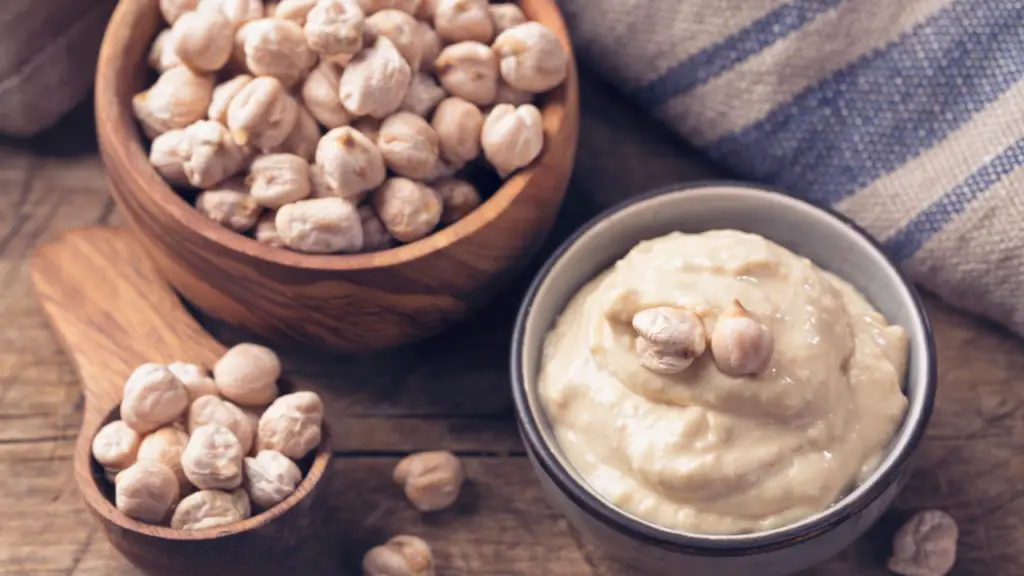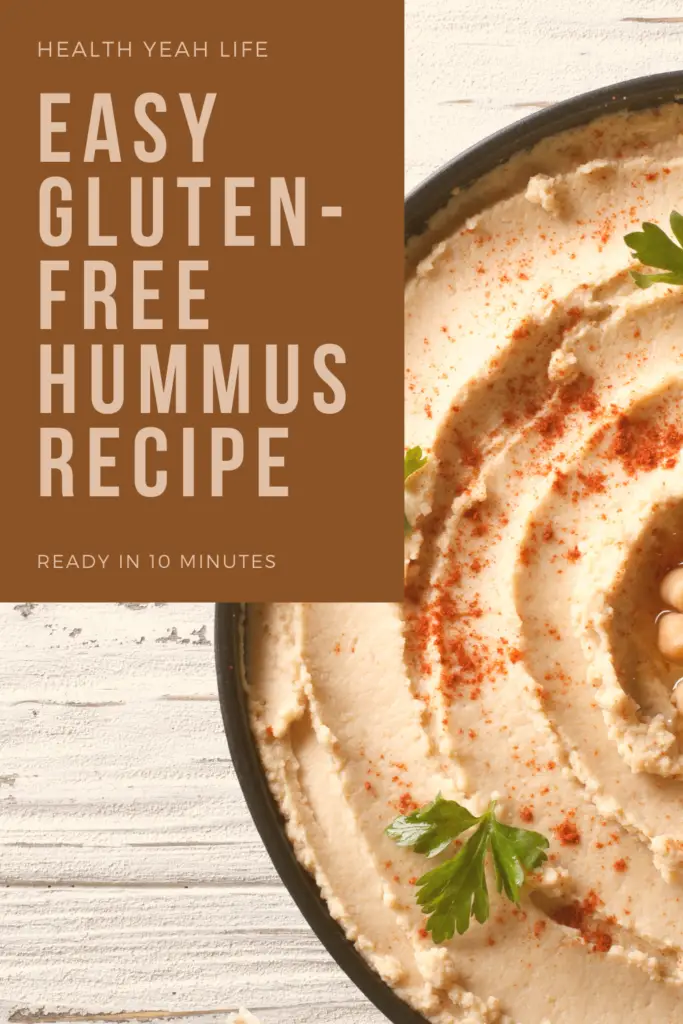Hummus is one of the most nutritious yet flavorful healthy dips out there. It goes with just about anything from grilled veggies to the original cracker-hummus combo.
Whether you're devouring it as a snack or serving it as an appetizer, traditional creamy hummus never disappoints. And, let's not forget the flavored varieties that bring a whole new dimension to the classic version.
Leading a gluten-free lifestyle if you have celiac disease means keeping a close eye on your foods for gluten ingredients and cross-contamination risks. So, if you are a hummus lover, is hummus one of the components that carry a red flag for being gluten-contaminated? Let's find out!
Hummus- What Is It?
Hummus is a famous condiment that originated from the Middle Eastern region. Let's say that the deliciousness of hummus spread like wildfire, more than ever in the last decade. It is now eaten in many countries globally, but it remains a Middle Eastern traditional food.

Hummus is mainly a dip for crackers, tortilla chips, pita bread, and veggies. Although, there are varieties that differ from the original flavor and are eaten as side options. Besides a side and appetizer option, meat and cheese boards include hummus in them.
What Is Hummus Made From?
Hummus's main ingredients are garbanzo beans, known as chickpeas, tahini, garlic, fresh lemon, olive oil, and spices. Chickpeas are small, commonly beige-colored seeds that belong to the legume family. T
Tahini, a Mediterranean kitchen staple, is ground sesame seed paste. Garlic is a vegetable from the onion family, lemon is a citrus fruit, and olive oil is extracted from olives.
Aside from the classical version, flavored hummus can include additional ingredients. You can find exotic flavors such as roasted red peppers, roasted garlic, avocado, pumpkin, sweet potato, even chocolate!
The process is as easy as it gets. The chickpeas are first cooked, the most common method being slow-cooked, and then blended in a food processor. The remaining ingredients are added and blended once more.

It is then transferred to an airtight container and kept in a refrigerator for 3-5 days. This procedure on a commercial scale is primarily similar but uses large machinery for bulk production.
Gluten-Based Ingredients in Hummus
The original old-school hummus is made only from naturally gluten-free ingredients. None of the ingredients used in it contain gluten, as long as they're not cross-contaminated. There is a risk of canned chickpeas and processed tahini containing gluten, though, as with every other processed food.
Now, this was as far as unflavored, all-natural hummus goes. On the other hand, flavored hummus is a different case. Flavored hummus, mainly processed types, may include gluten-based additives. Manufacturers may add gluten-based flavorings, emulsifiers, thickeners, or preservatives in processed hummus.
It would be best to read the label and check the ingredients list. This goes out for individuals who are restricting gluten for a healthier change. For gluten intolerant individuals, no gluten ingredients in the list aren't the safest option. They should opt for products that are labeled gluten-free.
Gluten Cross-Contamination in Hummus
Cross-contamination in hummus can occur during two phases. Firstly, during processing in production facilities or cooking in restaurants. And, secondly, if someone dips a wheat-based cracker, pita bread, or any other food in the serving bowl.
Cross-contamination during the processing of hummus is unavoidable unless the manufacturer has a dedicated gluten-free manufacturing site. Manufacturing of other gluten-based products and storage or transport with gluten-based products are the riskiest factors. So, even if a manufacturer isn't using gluten-based ingredients or additives, it doesn't omit cross-contamination risks in the product.

Dining out can also increase the chances of accidental gluten consumption due to cross-contamination. Restaurants that have classic hummus on their menu may still be using contaminated kitchen utensils for the hummus. When the restaurant isn't gluten-free only or doesn't have an official gluten-free menu, cross-contamination is inescapable.
Lastly, gatherings, parties, and movie nights may have that one hummus bowl that is shared. The hummus itself may be gluten-free of ingredients and cross-contamination during the making. But consider the scenario where someone dips their wheat-based chips in it.
It no longer remains gluten-free since gluten can contaminate the whole serving with a single dip. In this case, it's best to have a separate gluten-free bowl that doesn't go near that those wheat-based crackers.
Is Hummus Dairy-Free and Vegan?
Hummus goes with essentially any diet you're planning to follow. It does not contain any source of dairy products despite the creaminess provided by the chickpea blend and tahini.
Neither does it have eggs and is suitable for those following a Lacto-vegetarian, pescatarian, or vegan diet. Plus, natural hummus does not contain any animal-derived products or additives. However, manufacturers may add them during processing.

Therefore, it's crucial to ensure the brand exclusively states its hummus to be vegan-friendly. Natural, organic hummus is always gluten-free, dairy-free, wheat-free, nut-free, and vegan, making it the perfect snack food for everyone!
Reasons You Should Be Eating Hummus
This Middle Eastern condiment sets off mouthwatering, finger-licking flavors as soon as you take a bite. But that's not all! There are other reasons hummus should make its way into your kitchen staples and monthly grocery run. Here are some reasons hummus is THE ideal food you're missing out on if you haven't tried it yet.
It's Reasonably Priced
Hummus is a low-cost friendly food staple that you can find at the grocery store. The average price of a 10 oz container of classic hummus is around $2-5, depending on the brand. Flavored hummus costs a bit more, but those are worth the money, too, if you're looking for new tastes. Homemade hummus is the cheapest option. You can easily make around 1 ½ cup of hummus for under $2.
It's Convenient When You Are On The Run
A dollop of hummus when you're running late is all you'll need to satisfy your hunger. It's so much better for you than eating junk food whenever your stomach starts growling. Grab your favorite gluten-free crackers with it too, or maybe a few of your favorite raw veggies. Hummus comes in especially handy when planning a hike or road trip and needs something nutritious for the ride.
It's Easily Available
Unlike other cultural foods that are difficult to find in the US, hummus is available almost everywhere. Your local grocery stores will have some varieties of hummus. If not, there's always the option of large retail stores like Walmart, Target, and Trader Joe's.
People who don't prefer stepping out of the house can easily buy hummus from Amazon or other online grocery stores. We're saying that there are numerous options from where you can get your hands on hummus. And, most of these options are convenient, reliable, and accessible to almost everyone.

Health Benefits of Hummus
There are a handful of fulfilling and healthy snacks, and hummus makes it to the list. Hummus includes all things healthy and nutritious, especially the main ingredient, i.e., chickpeas. It is also a great source of protein and dietary fiber and folate.
It is also loaded with magnesium, potassium, iron, vitamins A, E, and C. Hummus has anti-inflammatory properties from the chickpeas, reduces the risk of obesity, and regulates blood sugar. Hummus may prevent certain diseases like heart diseases, cancer, gut conditions, and type 2 diabetes.
It's one of the Few Diet-Safe Foods
Nowadays, almost every food item needs to be heavily scrutinized before adding it to your meals. It's the era where poultry animals are being injected with hormones and crops are crowded with chemicals and GMOs.
Amidst these concerning factors, hummus is a food that's healthy and comparatively less processed. Thus, hummus is one of the safest foods for almost any diet. It doesn't contain any wheat, nuts, dairy, gluten-based grains, or animal-derived products either.
You'll Never Get Bored
Well, you can't eat hummus every other day and make it a significant part of your diet. Or can you? Contrary to people's assumption that regularly eating hummus will bore their tastebuds, it doesn't have to be this way.
There are many varieties of flavored hummus and more flavors entering the market with each passing day. You can grab 2-3 different flavors each time or make homemade versions and mix and match. As long as you're buying gluten-free brands, you don't need to restrict yourself to classic hummus. Our make your own gluten-free recipe at home
How to Make Gluten-Free Hummus

- Total Time: 10 minutes
- Yield: 1 ½ cup
Ingredients
- 1 ½ cup chickpeas- canned/cooked
- 1 garlic clove
- ¼ cup lemon juice
- ¼ cup tahini
- 2 tablespoons extra virgin olive oil
- 2 tablespoons water
- Salt and pepper to taste
Directions
- Combine the lemon juice and tahini in a food processor and process for 30 seconds.
- Add olive oil, garlic, salt, and pepper and process for thirty seconds.
- Add the first half of the chickpeas and process for a minute. Then add the second half and repeat.
- Gradually add the water while processing at the end for a balanced, creamy texture.
- Take out the hummus and place it in a bowl. Add a dash of paprika and drizzle with olive oil.
- Serve and enjoy!
Gluten-Free Hummus Brands
On a gluten-free diet, you'll be on the lookout for gluten-free hummus brands. Of course, nothing compares to homemade hummus in terms of deliciousness. Sometimes though, the easy store-bought option works too. Here are a few brands that sell gluten-free hummus varieties and are readily available!
- Fantastic Foods– All natural, Kosher and Vegan, No Wheat, Gluten, or Yeast
- Sabra Hummus- Vegan, Gluten-Free, Non-GMO
- Hope Foods– Non-GMO, Vegan, Certified Kosher, Certified Gluten-Free
- Wild Garden– Vegan, Certified Gluten-Free
- Simply Organic– Certified Organic, Non-GMO, Gluten-Free
- Cedar's– Certified Gluten-Free, Certified Kosher, Non-GMO Verified
- Kirkland Signature– No Preservatives, USDA Organic, Gluten-Free
Final Words
Hummus goes with everything. Whether you're a classic hummus and crackers person or you're the hummus dressing on salad type. This delicacy will always save the day as your venture through a gluten-free lifestyle.

As long as you're looking out for hidden gluten and opting for gluten-free brands, hummus is a gluten-free lifesaver. Consider your gluten sensitivity levels and then decide whether you should go for “no gluten ingredients,” labeled, or certified gluten-free.
Quick & Easy Gluten-Free Hummus Recipe
Equipment
- Food Processor
Ingredients
- 1 1/2 Cups Chickpeas Canned or Cooked
- 1 Clove Garlic
- 1/4 Cup Lemon Juice
- 1/4 Cup Tahini
- 2 Tbsp. Extra Virgin Olive Oil
- 2 Tbsp. Water
- Salt & Pepper to taste
Instructions
- Add the lemon juice and tahini to a food processor and process for 30 seconds.
- Add olive oil, garlic, salt, and pepper and process for thirty seconds.
- Add the first half of the chickpeas and process for a minute. Then add the second half and repeat.
- Gradually add the water while processing at the end for a balanced, creamy texture.
- Take out the hummus and place in a bowl.
- Add a dash of paprika and drizzle with olive oil.
- Serve and enjoy!
The owner of this website, HealthYeahLife.com is a participant in the Amazon Services LLC Associates Program, an affiliate advertising program designed to provide a means for sites to earn advertising fees by advertising and linking HealthYeahLife.com Review to Amazon properties including, but not limited to, amazon.com.
Below is a Pinterest-friendly photo…. so you can pin it to your Gluten-Free Recipe Board!!







